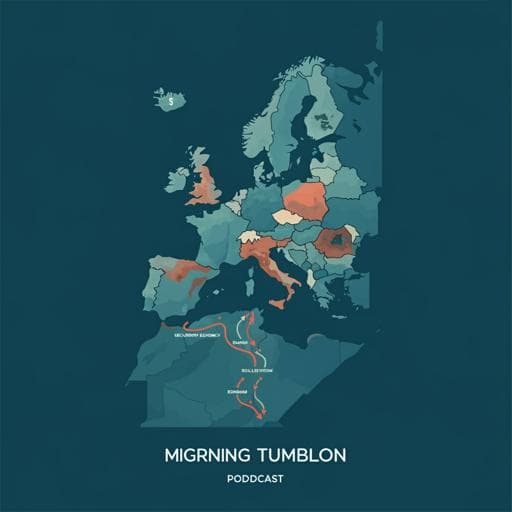
Political Science
A Great Divide: Polish media discourse on migration, 2015–2018
M. Troszyński and M. El-ghamari
Explore the sharp divide in Polish media discourse on migration between 2015 and 2018. Conducted by Marek Troszyński and Magdalena El-Ghamari, this study uncovers how conservative outlets frame migration as a security threat, while liberal sources advocate for solidarity with migrants. Discover the nuances of tabloid media in this compelling analysis!
~3 min • Beginner • English
Introduction
The study examines how Polish media constructed discourse on migration during 2015–2018, a period marked by large-scale arrivals to the EU and significant shifts in Polish political rhetoric. Poland’s context differs from other EU countries: immigration is largely economic with Ukrainians comprising the largest group of foreign workers, while emigration still exceeds immigration. The crisis became a salient issue in the 2015 parliamentary and 2018 local elections, coinciding with a rapid move toward strong anti-immigrant rhetoric in domestic politics. In a hybrid media system, the press and online outlets shape agendas and opinion, amid growing political polarization in media ecosystems. The study focuses on two ideologically contrasting dailies—Gazeta Wyborcza (liberal) and Gazeta Polska Codziennie (conservative)—and treats tabloids as a distinct discourse. The aim is to map main topics, track dynamics over time, and analyze how securitization frames permeate Polish media discourse on migration.
Literature Review
The paper situates its analysis within securitization theory, chiefly the Copenhagen School’s conceptualization of securitization as a speech act that elevates an issue beyond normal politics (Buzan, Wæver, de Wilde). It reviews developments and critiques emphasizing audience-centered, power-laden, and context-dependent aspects (Balzacq), as well as the Paris School’s sociological variant (Bigo) that stresses intersubjectivity between securitizing actors and audiences. Debates include limits in explaining why some securitizing moves succeed, the need to account for gradations of securitization strength, and the expansion of security to encompass migration. The review also discusses broader media polarization trends and agenda-setting effects in hybrid media systems, and clarifies key migration categories (“migrant” vs. “refugee”) noting their blurred use in public discourse. This theoretical grounding frames the study’s focus on how Polish media constructed migration as a security issue and how political polarization shaped that construction.
Methodology
Design: Mixed-method media content analysis combining corpus linguistics (CL) and critical discourse analysis (CDA). Data collection: • Timeframe: January 1, 2015–December 31, 2018. • Media monitored: TV (TVP1, Polsat, TVN, TVP Info, TVN24); Press (Fakt, Super Express, Gazeta Wyborcza, Dziennik Gazeta Prawna, Rzeczpospolita, Gazeta Polska Codziennie; weeklies: Gość Niedzielny, Polityka, Newsweek Polska, Sieci, Tygodnik Do Rzeczy); Internet portals (wp.pl, onet.pl, interia.pl, gazeta.pl, polki.pl). • Keyword query (Polish): migracje OR *migrant OR *migrantka (emigrant, immigrant, migrant, emigrantka, imigrantka, migrantka) OR uchodźcy OR nachodźcy. Corpus: 18,563 texts (press, TV, online), grouped by title and publication date. CL procedures: • Tools: SketchEngine (lemmatization, frequency lists, keyword/term extraction, collocations; reference corpus plTenTen12). • Preprocessing: Lemmatisation appropriate for Polish morphology. • Analyses: Frequency counts of human-referent nouns; keyword analysis with keyness scores; term extraction; collocation analysis for ‘immigrant/migrant’ using three patterns: modifiers (a_modifier), verbs with noun as subject (post_verb: “migrants do”), and verbs with noun as complement (prec_verb: “do X to migrants/with migrants”). • Subcorpora constructed for key press titles (e.g., Gazeta Wyborcza, Gazeta Polska Codziennie) and tabloids, enabling cross-discourse comparisons. CDA procedures: • Purpose: Qualitative interpretation of themes, contexts, and framing to complement CL findings and address limitations of purely quantitative text mining. • Sample: 200 articles purposively sampled for comparability across outlets. • Focal periods: September 2015 (peak of the crisis/media citations) and June 2017 (EC–Poland relocation dispute). • Coding: Researchers read texts to identify dominant themes (e.g., EU relocation, protests, security threats, far-right activity, public opinion shifts). Integration: Iterative comparison of CL outputs (keywords, collocations, frequencies) with CDA interpretations of concordance lines and article-level themes.
Key Findings
Corpus scope and temporal dynamics: • Total items: 18,563. Over half from press; 5,815 websites; 10,140 press; 2,608 TV. • Two peaks in coverage: – September 2015 (emergence of EU migrant crisis): websites jumped from 177 to 895 texts/month; press from 170 to 508; TV from 41 (Aug) to 353 (Sept). – June 2017 (EC–Poland dispute on relocation): press peak ~447 articles; legal-procedural context required explanatory coverage. Outlet-level volume patterns: • Liberal Gazeta Wyborcza (GW) published the most migration-related pieces overall. • Conservative Gazeta Polska Codziennie (GPC) showed sharp spikes (e.g., 20→82 articles at peak), amplifying hostile narratives. • Tabloids produced fewer migration articles than opinion-forming press and often used labels like “refugees,” “illegal refugees.” Lexical frequencies (human-referent nouns): • GW: ‘człowiek’ [person] (RF 2321), ‘uchodźca’ [refugee] (RF 1931), ‘imigrant’ [immigrant] (RF 1356). • GPC: ‘imigrant’ [immigrant] (RF 3325), ‘uchodźca’ [refugee] (RF 2096). • Tabloids: ‘uchodźca’ [refugee] (RF 4506), ‘człowiek’ [person] (RF 2718), ‘imigrant’ [immigrant] (RF 2299). Interpretation: tabloids overrepresented ‘refugee’; GW foregrounded ‘person’ and refugee; GPC foregrounded ‘immigrant.’ Keyword/term extraction contrasts (examples): • GPC: “nielegalny imigrant” [illegal immigrant] (key), “muzułmański imigrant” [Muslim immigrant], “fala imigrantów” [wave of immigrants], “wschód Ukrainy” [east Ukraine]. • GW: “status uchodźcy” [refugee status], “fala uchodźców” [wave of refugees], focus on far-right abroad (“Le Pen,” “skrajna prawica,” “Złoty Świt”). • Tabloids: numerically framed terms (“sprawa uchodźców” [issue of refugees], “liczba uchodźców” [number of refugees], “tysiąc imigrantów” [one thousand migrants]). Collocations around ‘immigrant/migrant’: • Most frequent modifier across discourses: “nielegalny” [illegal], underscoring legal framing. • ‘Muzułmański’ [Muslim] collocates frequent in GPC and tabloids, usually negative. • Post_verb patterns indicate tone differences: – GPC: ‘przemycać’ [smuggle], ‘podpalić’ [set fire], ‘zgromadzić’ [gather] → negative connotations. – GW: ‘szturmować’ [storm], ‘zapłacić’ [pay], ‘przybywać’ [arrive] → more neutral/varied. – Tabloids: ‘uciec’ [escape], ‘próbować’ [try], ‘kryć’ [hide] → focus on flight and dramatic events. • Prec_verb (verbs governing migrants): – GPC/GW: ‘przyjmować’ [accept] salient; GPC frames against acceptance. – Tabloids: ‘przemycać’ [smuggle], ‘zaatakować’ [attack], ‘bać (się)’ [fear] → explicit threat/fear framing. CDA thematic patterns: • September 2015: – GW emphasized EU relocation policy, European solidarity, and historical Polish refugee assistance; de-emphasized security sensationalism. – GPC highlighted migrant activities/riots in Balkans/Hungary, protests against quotas, and a vision of Europe being overwhelmed; strong security/“civilizational” threat tone. – Tabloids (Fakt, Super Express) stressed fear, numbers, “Arab invasion,” anti-German/EU narratives, dramatic visuals of unrest. • June 2017: – GW: Polish–EU conflict over quotas; attitudes to Ukrainian migrants; Poles’ growing fear; EC proceedings. – GPC: criticized EC; chronicled terror attacks abroad, smuggling, alleged migrant crimes; comprehensive threat framing. – Tabloids: migrant riots, EC vs. Poland, public opinion polls; fear-based selection. Overarching patterns: • Security lens permeates all discourses; right-wing outlets apply it more intensely. • ‘Illegal immigrant’ is consensually salient; ‘No one is illegal’ slogan appears rarely. • Religion–national identity cleavage surfaces via “Muslim migrants,” especially on the right; Ukrainians are framed more positively as culturally proximate and economically beneficial. • Terms “migrant” and “refugee” are used interchangeably in media practice. • Overall tone ranges from moderately negative (GW) to strongly negative (GPC); tabloids heighten emotionality and fear while not consistently aligning with a single party line. • Media agenda-setting produced two activity peaks (2015 EU crisis; 2017 EC–Poland dispute), with the latter reflecting domestic political agenda control.
Discussion
The findings address the study’s aim by showing that Polish media discourse on migration bifurcates into liberal and conservative camps with distinct value framings and security emphases. Drawing on integrated threat theory, the discourses cue both symbolic (cultural/religious) and realistic (safety/economic) threats, with conservative/right-wing outlets accentuating symbolic and security threats, constructing a ‘war of civilizations’ narrative. Liberal media foreground European solidarity and the global context, while gradually incorporating more threat language following public mood shifts. The pervasive securitization frame—evident in the centrality of ‘illegal immigrant’ and fear-laden collocations—demonstrates how speech acts elevate migration as an existential issue. In a hybrid media environment, polarization and filter bubbles likely amplify these divides, transforming migration from a policy challenge into a political weapon. Tabloids, though less tied to party lines, intensify emotional and numerical framings that can reinforce fear. These dynamics have broader implications: media polarization around migration may generalize to other policy domains, contributing to societal polarization and shaping voter perceptions in ways that benefit dominant parties.
Conclusion
The study provides the first comprehensive, mixed-method analysis of Polish media discourse on migration during 2015–2018, demonstrating: (1) a pronounced liberal–conservative divide; (2) the dominance of securitization frames across outlets; (3) two major coverage peaks linked to EU-level developments and domestic agenda-setting; and (4) a broadly negative affective tone, stronger on the right. It shows that ‘migrant’ and ‘refugee’ labels are used interchangeably, and that religion and national identity are central to right-wing narratives, while Ukrainians are framed as culturally/economically compatible. These insights clarify how media shape public attitudes and political conflict over migration. Future research could expand reception studies to assess audience effects, analyze social media-native content and interaction networks, compare beyond Poland to regional neighbors, and model temporal dynamics of securitization strength across issues.
Limitations
• CDA sample size: qualitative analysis was limited to 200 articles due to time/resource constraints, potentially omitting some themes. • CL method constraints: corpus techniques focus on formally defined items and cannot capture reception, discourse dynamics, or full contextual structures; qualitative validation mitigates but does not eliminate this. • Keyword-based retrieval: reliance on specified Polish keywords may miss relevant articles using atypical terminology or metaphors. • Media scope: while broad (press, TV, major portals), it does not include all social media or alternative outlets where migration discourse may differ. • Temporal and national focus: findings pertain to Poland during 2015–2018 and may not generalize to other periods or countries without caution.
Related Publications
Explore these studies to deepen your understanding of the subject.







